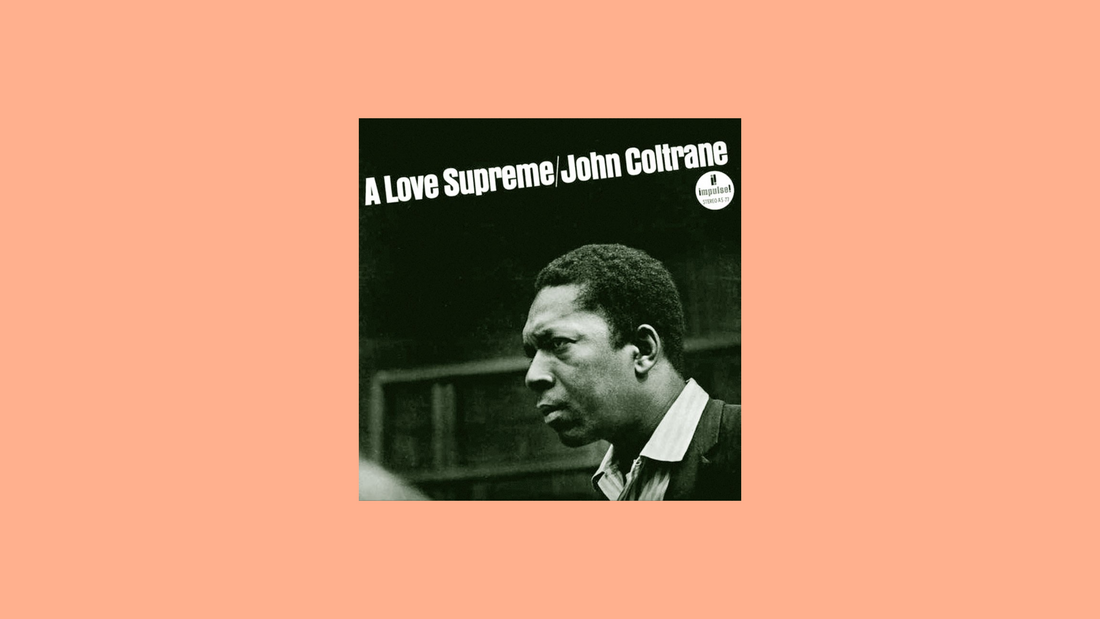
John Coltrane – A Love Supreme (1965)
By Rafi Mercer
It begins with a gong, a shimmer of resonance that feels less like a prelude than a call to order. Then the bass, insistent and circular, four notes repeated with the persistence of a mantra. Over this, Coltrane’s tenor voice enters, not hurried, not flamboyant, but solemn, purposeful. It is not a performance. It is a declaration. In that first minute of A Love Supreme, the listener is not being entertained — they are being summoned.
The album was recorded in December 1964 at Van Gelder Studio in Englewood Cliffs, New Jersey. The space itself mattered: Rudy Van Gelder’s high-ceilinged, wooden-walled studio had an almost ecclesiastical acoustic, lending warmth and depth to the sound. Coltrane arrived with his classic quartet — McCoy Tyner on piano, Jimmy Garrison on bass, and Elvin Jones on drums — a group whose chemistry was telepathic, honed by years of live performance. But A Love Supreme was something else. It was not simply another session; it was the crystallisation of Coltrane’s spiritual vision.
The suite unfolds in four parts: Acknowledgement, Resolution, Pursuance, Psalm. Each is distinct, yet each flows into the next, a single arc of devotion. Acknowledgement opens with Garrison’s bass figure, which underpins Coltrane’s theme. As the piece progresses, Coltrane begins to chant the words “a love supreme” — audible on the record if you listen closely, a human voice folded into the music. The chant makes explicit what the notes already convey: this is not jazz as entertainment, but jazz as prayer.
Resolution surges with Tyner’s piano chords, bright and insistent, Coltrane cutting through with a tone that is both searching and assured. Elvin Jones propels the piece forward with a drumming that is less rhythm than storm — rolling, unrelenting, elemental. Where Acknowledgement is invocation, Resolution is conviction. The music is not asking; it is affirming.
Pursuance is driven by Jones at his most volcanic, a polyrhythmic torrent that seems to summon Coltrane ever higher. Tyner’s solo here is one of his finest, a display of force and clarity that stretches modal jazz to its edge. Coltrane enters with lines that tumble and climb, cascading in sheets of sound, yet always tethered to the pulse of devotion. The urgency is not chaotic. It is disciplined intensity, a prayer spoken in tongues.
The final movement, Psalm, is the most extraordinary. Coltrane does not improvise in the usual sense. Instead, he plays as though reading a text — a devotional poem he had written, each note corresponding to a word or phrase. The saxophone becomes voice, syllabic, declarative. The effect is austere, almost liturgical. No rhythm section intrudes. The piece drifts, breath by breath, until it fades into silence, unresolved yet complete.
The power of A Love Supreme lies in its directness. Coltrane had already explored modal improvisation on earlier albums, and he would go further into the avant-garde with works like Ascension. But here he chose focus, discipline, unity. The suite has no filler, no digression. Its forty minutes feel inevitable, as though carved from a single block of stone.
Context deepens the record’s meaning. Coltrane had emerged from years of addiction and struggle. In 1957 he experienced what he described as a spiritual awakening, a moment of clarity and grace in which he vowed to dedicate his music to a higher purpose. A Love Supreme is that vow realised. It is at once intensely personal — a thanksgiving to God — and universal, a call to transcendence that listeners of any belief can enter.
The reception was immediate and profound. Released in early 1965, the album sold in numbers unusual for jazz of its ambition. Critics hailed it as a masterpiece. Musicians across genres — from rock to classical — cited it as influence. And audiences, even those unfamiliar with jazz, recognised its sincerity. This was music that did not posture. It testified.
To listen to A Love Supreme properly is to allow it to reshape the room. It is not background. It does not sit politely in the corner. The opening bass figure alters the air, asks for your attention, your stillness. The quartet’s interplay is not for display but for devotion. Tyner’s chords ring like stained glass struck by light. Jones’s drumming surrounds you like weather. Coltrane’s horn is at once cry, chant, and breath. By the time Psalm ends, the silence that follows feels consecrated.
The album’s influence endures not only in music but in thought. It has been analysed, quoted, referenced, mythologised. Yet its true power lies in experience. To play it in the evening, without interruption, is to participate in its ritual. One need not share Coltrane’s faith to feel its gravity. It speaks of struggle transfigured, of devotion articulated, of the possibility that sound itself can reach beyond sound.
More than half a century later, A Love Supreme has not dimmed. Its urgency is intact. Its sincerity still cuts through noise and distraction. It stands as one of the clearest examples of what music can be: not diversion, not product, but offering. A blueprint for listening not only with ears, but with presence.
Rafi Mercer writes about the spaces where music matters. For more stories from Tracks & Tales, subscribe, or click here to read more.














